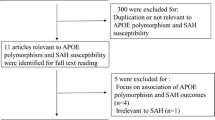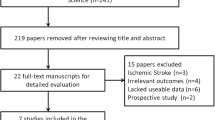Abstract
Intracerebral hemorrhage (ICH) is a serious clinical disease with high morbidity, whose pathogenesis might be related to apolipoprotein E (APOE) gene polymorphisms. To comprehensively evaluate the risk factors for ICH occurrence, we performed a meta-analysis. We searched online databases to identify eligible studies based on the relationship between APOE genetic polymorphisms and ICH occurrence risk. Specific and pooled odds ratios (ORs) were calculated and by assessing small study bias, we drew the relationship between APOE polymorphisms and ICH risk. We included 15 eligible studies in our study containing a total of 1642 ICH samples and 5545 normal controls. The comparison of ɛ4 and ɛ3 APOE genotypes revealed that specific and pooled ORs showed a significantly increased odds ratio in ICH patients with the ɛ4 genotype, indicating that ɛ4 gene is a risk factor for ICH occurrence, and the heterogeneity is acceptable. Similarly, it was found that the ɛ2 genotype also contributed to the incidence rate of ICH. However, after the subgroup analysis by ethnicity, this APOE genetic polymorphism acted as a harmful factor only in white populations, but did not show an effect in Asian populations. It was suggested that both ε2 and ε4 APOE alleles were risk factors for ICH in general. They were risk factors in white populations only, neither had a detectable effect in Asian populations after subgroup analysing by ethnicity.
Similar content being viewed by others
References
Brown RD, Whisnant JP, Sicks JD, et al. Stroke incidence, prevalence, and survival: secular trends in Rochester, Minnesota, through 1989. Stroke, 1996,27(3):373–380
Sturgeon JD, Folsom AR, Longstreth WJ, et al. Risk factors for intracerebral hemorrhage in a pooled prospective study. Stroke, 2007,38(10):2718–2725
Mahley RW. Apolipoprotein E: cholesterol transport protein with expanding role in cell biology. Science, 1988,240(4852):622–630
Hatters DM, Budamagunta MS, Voss JC, et al. Modulation of apolipoprotein E structure by domain interaction: differences in lipid–boud and lipid–free forms. J Biol Chem, 2005,280(40): 34 288–34 295
Ophir G, Amariglio N, Jacob–Hirsch J, et al. Apolipoprotein E4 enhances brain inflammation by modulation of the NF–kappaB signaling cascade. Neurobiol Dis, 2005,20(3):709–718
Atadzhanov M, Mwaba MH, Mukomena PN, et al. Association of the APOE, MTHFR and ACE Genes Polymorphisms and Stroke in Zambian Patients. Neurol Int, 2013,5(4):e20
Boumendjel S, Khodja D, Hamri A, et al. Apolipoprotein E polymorphism and cerebral stroke. Ann Biol Clin (Paris), 2013,71(1):21–26
Chen YC, Lee–Chen GJ, Wu YR, et al. Analyses of interaction effect between apolipoprotein E polymorphism and alcohol use as well as cholesterol concentrations on spontaneous deep intracerebral hemorrhage in the Taiwan population. Clin Chim Acta, 2009,408(1–2):128–132
Chowdhury AH, Yokoyama T, Kokubo Y, et al. Apolipoprotein E genetic polymorphism and stroke subtypes in a Bangladeshi hospital–based study. J Epidemiol, 2001,11(3):131–138
Das S, Kaul S, Jyothy A, et al. Association of APOE (E2, E3 and E4) gene variants and lipid levels in ischemic stroke, its subtypes and hemorrhagic stroke in a South Indian population. Neurosci Lett, 2016,628:136–141
Duzenli S, Pirim I, Gepdiremen A, et al. Apolipoprotein E polymorphism and stroke in a population from eastern Turkey. J Neurogenet, 2004,18(1):365–375
Garcia C, Pinho EMT, Rocha L, et al. Cerebral hemorrhage and apoE. J Neurol, 1999,246(9): 830–834
Kokubo Y, Chowdhury AH, Date C, et al. Agedependent association of apolipoprotein E genotypes with stroke subtypes in a Japanese rural population. Stroke, 2000,31(6):1299–1306
Seifert T, Lechner A, Flooh E, et al. Lack of association of lobar intracerebral hemorrhage with apolipoprotein E genotype in an unselected population. Cerebrovasc Dis, 2006,21(4):266–270
Tasdemir N, Tamam Y, Toprak R, et al. Association of apolipoprotein E genotype and cerebrovascular disease risk factors in a Turkish population. Int J Neurosci, 2008,118(8):1109–1129
Woo D, Deka R, Falcone GJ, et al. Apolipoprotein E, statins, and risk of intracerebral hemorrhage. Stroke, 2013,44(11):3013–3017
Zhang R, Wang X, Liu J, et al. Apolipoprotein E gene polymorphism and the risk of intracerebral hemorrhage in the Chinese population. Genet Test Mol Biomarkers, 2012,16(1):63–66
Mccarron MO, Hoffmann KL, Delong DM, et al. Intracerebral hemorrhage outcome: apolipoprotein E genotype, hematoma, and edema volumes. Neurology, 1999,53(9):2176–2179
Catto AJ, Mccormack LJ, Mansfield MW, et al. Apolipoprotein E polymorphism in cerebrovascular disease. Acta Neurol Scand, 2000,101(6):399–404
Misra UK, Kalita J, Somarajan BI. Recurrent intracerebral hemorrhage in patients with hypertension is associated with APOE gene polymorphism: a preliminary study. J Stroke Cerebrovasc Dis, 2013,22(6):758–763
Corder EH, Saunders AM, Strittmatter WJ, et al. Gene dose of apolipoprotein E type 4 allele and the risk of Alzheimer’s disease in late onset families. Science, 1993,261(5123):921–923
Corder EH, Saunders AM, Risch NJ, et al. Protective effect of apolipoprotein E type 2 allele for late onset Alzheimer disease. Nat Genet, 1994,7(2):180–184
Bartzokis G, Lu PH, Geschwind DH, et al. Apolipoprotein E affects both myelin breakdown and cognition: implications for age–related trajectories of decline into dementia. Biol Psychiatry, 2007,62(12):1380–1387
Konialis C, Spengos K, Iliopoulos P, et al. The APOE E4 Allele Confers Increased Risk of Ischemic Stroke Among Greek Carriers. Adv Clin Exp Med, 2016,25(3):471–478
Falcone GJ, Radmanesh F, Brouwers HB, et al. APOE epsilon variants increase risk of warfarinrelated intracerebral hemorrhage. Neurology, 2014,83(13):1139–1146
Leclercq PD, Murray LS, Smith C, et al. Cerebral amyloid angiopathy in traumatic brain injury: association with apolipoprotein E genotype. J Neurol Neurosurg Psychiatry, 2005,76(2):229–233
Greenberg SM, Vonsattel JP, Segal AZ, et al. Association of apolipoprotein E epsilon2 and vasculopathy in cerebral amyloid angiopathy. Neurology, 1998,50(4):961–965
Tolar M, Keller JN, Chan S, et al. Truncated apolipoprotein E (ApoE) causes increased intracellular calcium and may mediate ApoE neurotoxicity. J Neurosci, 1999,19(16):7100–7110
Lynch JR, Pineda JA, Morgan D, et al. Apolipoprotein E affects the central nervous system response to injury and the development of cerebral edema. Ann Neurol, 2002,51(1):113–117
Davis SM, Broderick J, Hennerici M, et al. Hematoma growth is a determinant of mortality and poor outcome after intracerebral hemorrhage. Neurology, 2006,66(8):1175–1181
Liaquat I, Dunn LT, Nicoll JA, et al. Effect of apolipoprotein E genotype on hematoma volume after trauma. J Neurosurg, 2002,96(1):90–96
Biffi A, Anderson CD, Jagiella JM, et al. APOE genotype and extent of bleeding and outcome in lobar intracerebral haemorrhage: a genetic association study. Lancet Neurol, 2011,10(8):702–709
Alberts MJ, Graffagnino C, Mcclenny C, et al. ApoE genotype and survival from intracerebral haemorrhage. Lancet, 1995,346(8974):575
Raffeld MR, Biffi A, Battey TW, et al. APOE epsilon4 and lipid levels affect risk of recurrent nonlobar intracerebral hemorrhage. Neurology, 2015,85(4):349–356
Author information
Authors and Affiliations
Corresponding authors
Additional information
This study was supported by the National Natural Science Foundation of China (No. 81471201 and No. 81171089).
Rights and permissions
About this article
Cite this article
Nie, H., Hu, Y., Liu, N. et al. Apolipoprotein E Gene Polymorphisms Are Risk Factors for Spontaneous Intracerebral Hemorrhage: A Systematic Review and Meta-analysis. CURR MED SCI 39, 111–117 (2019). https://doi.org/10.1007/s11596-019-2007-5
Received:
Revised:
Published:
Issue Date:
DOI: https://doi.org/10.1007/s11596-019-2007-5




